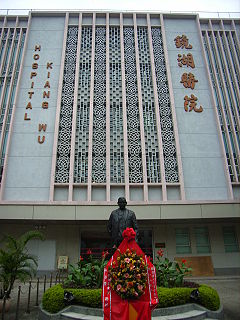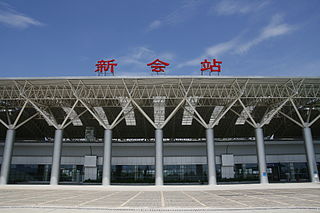
Jiangmen, alternately romanized in Cantonese as Kongmoon, is a prefecture-level city in Guangdong Province in southern China. Its 3 urban districts are now part of the Guangzhou–Shenzhen conurbation and the entire prefecture had a population of about 4.45 million in 2010.

Xinhui, alternately romanized as Sunwui and also known as Kuixiang, is an urban district of Jiangmen in Guangdong, China. It grew from a separate city founded at the confluence of the Tan and West Rivers. It has a population of about 735,500, 98% of whom are Han Chinese but many of whom speak a dialect of Cantonese as their first language. Xinhui is best known in China for its chenpi, a kind of dried Mandarin orange peel.

Zhengzhou University, colloquially known in Chinese as Zhèngdà (郑大) and abbreviated as ZZU is a public university located in Zhengzhou, Henan, People's Republic of China. Zhengzhou University is the largest university in China in terms of number of students. The Campus size is the tenth largest in PR China with 433 hectares.

Capital Medical University, also known as CMU, is a university in Beijing, China, which was originally called Beijing Second Medical College (北京第二醫學院).

Taipei Medical University in Taiwan is located in Taipei's Xinyi District. Founded as Taipei Medical College in 1960, it was renamed as Taipei Medical University in 2000.

The Hospital Authority is a statutory body managing all the government hospitals and institutes in Hong Kong. It is under the governance of its board and is under the monitor of the Secretary for Food and Health of the Hong Kong Government. Its chairman is Henry Fan.

Conde S. Januário Hospital is an acute care hospital run by the public sector in Sé, Macau, China.

Kiang Wu Hospital is a privately owned hospital located in Santo António, Macau, China. It is one of the three hospitals in Macau. Founded in 1871, the hospital is run by the Kiang Wu Charitable Association and offered Chinese medical services. Renowned doctor Sun Yat-Sen brought Western medicine services to the hospital. The hospital has had four different sites, the last built in 2000.
Port of Guangzhou is the main seaport of Guangzhou city, Guangdong province, China. The port is operated by Guangzhou Port Group Co. Ltd which is a state owned company. The company was established on February 26, 2004 from the former Guangzhou Harbor Bureau. It was approved by the Guangzhou Municipal Government. It is currently the largest comprehensive port in South China. Its international maritime trade reaches over 300 ports in more than 80 countries and districts worldwide. The port also incorporates the former Huangpu Port.

Southern Medical University, formerly known as First Military Medical University, affiliated to the People's Liberation Army of China, is an institution of higher learning in Guangzhou, the capital city of Guangdong Province, China. It was founded in 1951 and became a national key universities in 1979. Approved by the State Council and the Central Military Commission of the PLA, the university came under the jurisdiction of Guangdong Province in August 2004, whereupon it was renamed Southern Medical University.

Renji Hospital is a general hospital in the Pudong District of Shanghai, China, with the rank of "Grade 3, Class A". The hospital is a university hospital affiliated to the Shanghai Jiao Tong University School of Medicine.

Xinhui railway station is an elevated terminus of Guangzhou-Zhuhai Intercity Mass Rapid Transit Jiangmen Spur Line. It started operation on 7 January 2011.

Wuguishan Subdistrict is a subdistrict of the prefecture-level city of Zhongshan, Guangdong province, China. It has a population of 7,400 permanent residents and more than 20,000 migrants.

Xili,, an area of Nanshan District, Shenzhen, South China, covers an area of 46.93 square kilometres (505,200,000 sq ft), with the population of 210,000 or more, including household population of 19,323. It has eight communities - Dakan, Makan, Baimang, Lihu, Xinwei, Xili, Shuguang and Songping Shan. The bordering areas are Taoyuan, Yuehai and Nantou communities and Bao'an District. Tang Lang New Village, is also found in Xili. University Town of Shenzhen, apartments for migrant workers and the Xili People's Hospital are located in the area.
Sze Yup Cantonese are a Han Chinese group coming from a region in Guangdong Province in China called Sze Yup (四邑), which consisted of the four county-level cities of Taishan, Kaiping, Xinhui, and Enping. Now Heshan has been added to this historic region, and the prefecture-level city of Jiangmen administers all five of these county-level cities, which is sometimes informally called Ng Yap. Their ancestors are said to have arrived from what is today central China about less than a thousand years ago and migrated into Guangdong around the Tang Dynasty rule period, and thus Taishanese as a dialect of Yue Chinese has linguistically preserved many characteristics of Middle Chinese.
Yámén is a town lying in the south of Xinhui District of Jiangmen, Guangdong, People's Republic of China. It covers an area of 281 square kilometers and has a population of 40,000.

Chaolian Subdistrict is a subdistrict of Pengjiang District, Jiangmen, Guangdong, China. It covers an area of 12.68 square kilometers, and has a registered population of 12,808 as of 2008.
Jinhua street is a grid of streets in the city of Guangzhou in the Liwan District of China.

Masaka Hospital, Rwanda, commonly known as Masaka Hospital, is a hospital in Rwanda. It is an urban, general hospital built between 2008 and 2011, with funding from the Government of China, as a gift to the Government of Rwanda.














